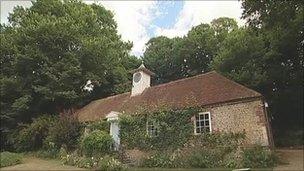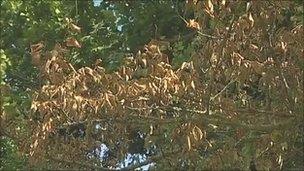Dutch elm hits stronghold of healthy trees in Sussex
- Published

Withered brown leaves are one of the first signs of Dutch elm disease
An increase in Dutch elm disease is threatening one of Britain's last strongholds of Victorian trees.
East Sussex has one of the country's largest populations of mature elms after controls were set up in 1973 to limit the spread of the disease.
But the county council said it had to spend £18,000 felling infected trees last year, three times the amount it would have spent 10 years ago.
"Unfortunately there is no cure and no way of saving infected trees," it said.
Infected bark
More than 30 million specimens across the country were lost to Dutch elm disease in the 1970s.
Sussex and Hampshire, along with Brighton, now have the largest remaining populations dating from the 1800s and earlier.
The disease is transmitted by beetles which eat through infected bark and pass on the fungus. It then spreads further from tree to tree through their systems.
But the south coast populations were protected by their positioning between the English Channel and the South Downs.
One of the private estates affected by the increase in the spread of Dutch elm is Charleston Manor in West Dene, which has a large collection of trees, many of them more than 200 years old.

Withered brown leaves are one of the first signs of Dutch elm disease
Several had to be felled last year and more are now showing signs of of disease, which begins with withered brown leaves.
"There are a lot of elms that have recently got the disease," said Mary Parker, Dutch elm disease control officer for the county council.
"In other trees the disease has gone right the way down through the tree and it is now travelling through the roots to the next one and the next one."
The county council said each local authority in the East Sussex Control Zone was responsible for felling infected trees on land it owned or controlled.
"In the rural area between Eastbourne and Brighton, the South Downs Joint Committee carries out control work on behalf of private landowners with private landowners making a 50% contribution towards the costs," it said.
"We are responsible for trees on the public highway and where we come across infected trees we will cut them down and burn the timber to limit the spread of this disease."
Brighton and Hove council, which controls a population of about 15,000 specimens, said it was not immune to Dutch elm disease but had not noticed any particular increase in the city.